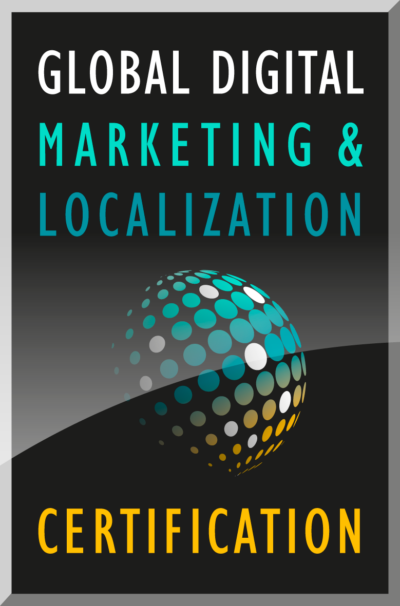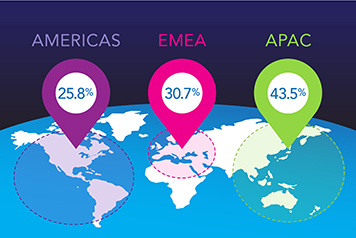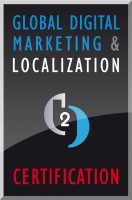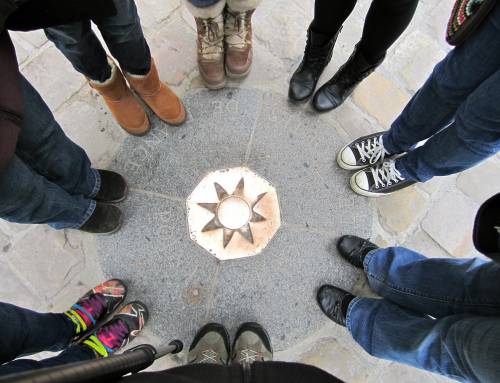This is a paper presented by Chinedu Mkpuluma, a recent graduate of the Global Digital Marketing and Localization Certification (GDMLC) program. This paper presents the work being produced by students of The Localization Institute’s Global Digital Marketing and Localization Certificate program. The contents of this Paper are presented to create discussion in the global marketing industry on this topic; the contents of this paper are not to be considered an adopted standard of any kind. This does not represent the official position of Brand2Global Conference, The Localization Institute, or the author’s organization.
Geography. You may have taken a class on it in school years ago, but how often do you think about it now? If you’re a marketer, the answer should be a lot.
Spatial distribution, a key element of geography, plays a big role in marketing—mainly due to the push for increased market share in untapped economies, market segments, and locales. Organizational expansion goals force managers to consider increasingly more complex spatial delivery and advertising systems to launch, manage and promote products in different markets, according to a 2002 paper by UCLA researchers Bart J. Bronnenberg and Paulo Albuquerque.
They are not the only ones who have taken an interest in in the spatial aspects of growth and market structure. Many researchers in business, economics, and marketing are studying what is known as ‘new economic geography.’ It’s a subfield of geography involving the study of location, distribution, and spatial organization of economic activities across the world. As marketers, the role geography plays in marketing and localization is something we all need to understand.
Location, location, location
Important to ‘new economic geography’ is a technology known as Geographic Information Systems (GIS), which helps link locations to information and allows businesses to visualize where their customers are located. GIS analyzes demographic, psychographic, purchasing, and spending characteristics for accurate customer segmentation, and puts the pieces together to help organizations make better strategic decisions.
Knowing the geographic location of their customer base can help marketers make smart decisions when placing brand or product offerings across geographies or locales. Once company understands the value of location and the role a wider spatial distribution plays in its marketing mix, it can apply the necessary pieces of information and intelligence at the right points within the organization and locales outside the organization to maximize the impact of its marketing efforts and hopefully increase sales.
Take, for example, the Texas department store that analyzed its credit card receipts by ZIP code (ESRI 2008). Through that simple exercise, the company discovered that a large number of its customers drove along a particular section of the freeway to reach a mall. Knowing the route its customers traveled enabled the store make some intelligent, strategic choices about where to place its billboard ads. The end result? Improved sales.
As this store discovered, linking location to information is a process that touches many aspects of decision-making. Choosing a site, targeting a market segment, planning a distribution network, zoning a neighborhood, allocating resources, and responding to emergencies—all involve questions of geography. Where are the customers and potential customers? In which neighborhoods or ZIP code areas do consumers with particular profiles live? Which areas of a city are most vulnerable to seasonal flooding or other natural disasters? Where are power poles located, and when did they last receive maintenance, etc.?
Geographical/locational information and intelligence aid the company’s marketers and location and space managers in predicting consumers’ behavioral patterns, which inform the go-to-market strategies to reach consumers, enter new geographies, and place stores across geographies or locales.
According to Houldsworth (2003), geography matters in marketing because it is the key factor in being able to extrapolate known information onto persons, households, or areas that up to that point had little or no information. Through this process, marketers can more accurately infer intelligence that can be crucial to business growth across geographies and locales. In this way, location becomes one of the most valuable, yet most under-utilized, tools available to business and organizations.
The bigger picture
Geographical information can help marketers worldwide see the bigger picture, align with the culture in various locales, and become more agile and responsive in seizing new market opportunities to stay ahead of the competition. It saves time, money, and resources by pinpointing the largest concentrations of customers, identifying what these consumers are purchasing, and understanding how far they are willing to travel for these goods or services. Customer databases use every transaction to gather vital location information that can be used to identify typical customers and their unique buying habits, and ensure that marketing messages resonate with existing and prospective customers.
Below are examples of how household companies use GIS technology to analyze markets, increase the efficacy of specific locations and anticipate customer needs (The University of Southern California, 2017).
- Wendy’s – When deciding where to open new stores, Wendy’s uses GIS technology. GIS gathers data such as area demographics and sales records for Wendy’s to help the company decide on locations. GIS applications pull from census data and other publicly available data lists, and uses applications to give the data to Wendy’s employees in a way they can use. Wendy’s does not just use GIS to look for potential customers; it also uses the technology to scout out potential employees in the area. Wendy’s also uses GIS to monitor existing stores, like logging customer complaints and understanding purchasing habits of local customers.
- GM – GM has recently begun putting GIS technology in the hands of its dealers. The valuable information GIS provides about demographics and other local information now helps dealers as well as the larger company figure out where the markets are, how far from the dealerships they are, and even how competitive the car dealership industry is in a specific area. GIS technology has helped GM determine valuable statistics that it didn’t have before, such as how long people are willing to travel to get the best deal on a car. Handing the information down to the dealers helps the company as a whole perform more efficiently and save money.
- Starbucks – In 2007, Starbucks opened, and then closed, hundreds of stores, in part because of faulty growth strategies and a lack of ability to analyze the volumes of data is collected via GIS. Now, Starbucks is in the process of opening about 1,500 stores in the U.S., and this time the company is much more confident because it has focused its GIS technology on gathering data in a way that employees can understand, and use, in applications that pertain to real estate, customer needs, and convenient new store locations.
The right message
Geographic data and localization play a key role in seizing new business opportunities by offering background and intelligence that can improve the relevance of marketing communications across locales for brands and companies. With increasing competition for market share, the role and relevance of geography in helping to improve marketing communication strategies are increasingly evident. Communications are no longer one-size-fits-all—messages are now carefully tailored to specific geographies for the greatest impact.
Since culture is spread across geographies, marketers want to develop their messaging and offerings to integrate seamlessly with local cultures. Companies that recognize the impact of geography are moving toward Web globalization[1] and localization[2], including a heavy focus on translation and transcreation[3], which allow them to understand and communicate more effectively with customers and end-users in their current markets and in prospective/untapped locales around the world.
MarketingProfs (2011) found that 44 percent of marketers list geography/location as one of the factors that influence the localization of marketing messages. According to Jacob’s 2005 paper, “A Geography of Big Things,” translation brings into view the multiplicity of the world and confirms that reaching one position from another always requires a great deal of work. In marketing, this work uses “cultural geography”— information and data about the cultural and language connotations, linguistic distinctions, and idiomatic expressions of each geography and locale—to craft customized multi-geography print and digital marketing campaigns, programs, and messaging that resonate with the users in these markets.
Forward-thinking companies have even used this concept to develop products for wider audiences. According to Bhargava in Culture Vulture (2013), this shift in product development permits the maximum number of consumers to access a company’s products or services. For companies to achieve maximum access to their products, they have to move beyond their immediate boundaries—locally, regionally, or globally.
The global market is of particular importance, because most markets in emerging economies have massive growth potential and are far less saturated. For example, the North American market accounts for a mere 14 percent of the entire global market. This means companies that focus only on the North American geography fail to reach 86 percent of consumers across broader geographies.
Connecting people and resources
Geography suggests to businesses the places where products, goods and services are likely to succeed. With the help of data, it can also tell companies what customers in particular locales want.
Geography may be the umbrella term for the multifarious interactions that occur on a global scale, but for marketers, its meaning can be succinctly stated: connect people and resources. According to Dunham (2015), geography matters, plain and simple. One of the foundational methodological commitments of cultural geography is the imperative to attend to the small, the minor, and the exceptional in making ‘big’ geographies.
Forrester’s Cooperstein sums it up in a CMO article by stating that, for any brand that crosses geographic boundaries, companies must carefully target geographies and recognize cultural differences in how their brand or industry is perceived (Overby, 2012). As marketers, this commitment should be at the forefront of all of our programs and campaign, whether they are local, regional or global.
References
Bronnenberg, B.J.; Albuquerque, P. 2002. Geography and Marketing Strategy in Consumer Packaged Goods. http://www.simon.rochester.edu/fac/albuquerque/papers/markgeog.pdf
Culture Vulture. 2013. Translation, Internationalization and Localization: Google’s Tips for Taking Your Website Global. http://www.kwintessential.co.uk/read-our-blog/translation-internationalization-and-localization-google-tips.html
Dunham, K. 2015. Why Geography Matters in Digital Marketing – The Case for Optimizing for Mobile and Local Search. http://blog.hzdg.com/stories/why-geography-matters-in-digital
ESRI. 2008. Geography Matters™. An ESRI ® White Paper. http://www.esri.com/library/whitepapers/pdfs/geography-matters.pdf
Houldsworth, D. 2003. Why Geography Matters in Marketing Strategy – The Spatial Dimension to Customer Communications and Marketing. http://www.directionsmag.com/entry/why-geography-matters-in-marketing-strategy-the-spatial-dimension-to-custom/123907
Jacob, J.M. 2005. A Geography of Big Things. Institute of Geography Online Paper Series: GEO-009. https://www.era.lib.ed.ac.uk/bitstream/handle/1842/820/jjacobs002.pdf?sequence=1
MarketingProfs. 2011. Brands to Focus on Localized Content Marketing. http://www.marketingprofs.com/charts/2011/6295/brands-to-focus-on-localized-content-marketing
Overby, S. 2012. Global Positioning: The Promise—and Pain—Of Multi-geography Marketing. http://www.cmo.com/features/articles/2012/1/9/global-positioning-the-promiseand-painof-multigeography-marketing.html
The University of Southern California, 2017. How Household Companies Use GIS. http://gis.usc.edu/msp-resources/articles-blogs/how-household-companies-use-gis/
[1] Globalization has a slightly different meaning in the localization industry and in general business. In the localization industry, it is seen more in terms of overall process terms; from the general business perspective, it has broader micro- and macro-economic market implications.
[2] Localization is creating marketing images/messaging that reflect the appearance/values of the specific locale, local population or market.
[3] Transcreation is the process that focuses on adapting content, ideas, messages etc. from one language to another while maintaining the context, intent, style and tone.
Author Bio:
 Chinedu Mkpuluma works in Digital Marketing for Ciena’s Global Marketing team where he works on different marketing programs and campaigns that focus on content strategy/development/management, SEO (organic search), web governance, web quality assurance, technical CMS implementation and support of globalization efforts.
Chinedu Mkpuluma works in Digital Marketing for Ciena’s Global Marketing team where he works on different marketing programs and campaigns that focus on content strategy/development/management, SEO (organic search), web governance, web quality assurance, technical CMS implementation and support of globalization efforts.
Connect with Chinedu
On LinkedIn
Email Chinedu
please click here. The program offers dual credentials, with a Certificate from the University of North Carolina Wilmington and a Certification from The Localization Institute.










